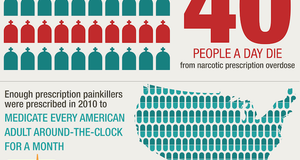Opinion:The Need for an Open Debate on Drug Legalization
By
2010, Vol. 2 No. 03 | pg. 1/1
KEYWORDS:
The question of the legalization of drugs has emerged sporadically throughout the past few decades of national and international politics, resulting in a plethora of opposing viewpoints. The heated debate has consumed the American public, and as of late, has virtually bombarded them with anti-drug ads and sentiment. The government has fueled its anti-drug campaign with ever-growing amounts of taxpayer money in order to insure the “evil” drugs are kept out of the hands of Americans. It has created an army of soldiers headed by a Drug Czar to fight the drug war in the form of the NDC, ATF, FBI, and others. According to the Office of National Drug Control Policy, “The U.S. federal government spent $19.179 billion dollars in 2003 on the War on Drugs, at a rate of about $600 per second” (Elrod). However, despite this huge amount of spending, the war on drugs has been almost a second Vietnam for the United States, an unfixable scenario where the drug flow into the country has only continued to increase each year. As a result of this, many have called for a policy shift toward legalization, feeling the current policy has failed. Others claim such a drastic action would be rash without first doing proper research. However, regardless of individuals’ opinions on the subject of legalization, both sides believe research should be done by the government on what would happen to society and the nation if drugs were legalized, each thinking it would validate their arguments. In his article “Drug Legalization: Time for a Real Debate,” Paul B. Stares discusses such a move toward researching, writing: In particular, a rigorous assessment of a range of hypothetical regulatory regimes according to a common set of variables would clarify their potential costs, benefits, and trade-offs. Besides instilling much needed rigor into any further discussion of the legalization alternative, such analysis could encourage the same level of scrutiny of current drug control programs and policies. With the situation apparently deteriorating in the United States as well as abroad, there is no better time for a fundamental reassessment of whether our existing responses to this problem are sufficient to meet the likely challenges ahead. (20).As result of the almost universal failure of the drug war, many believe, as Stares writes, it is time to reassess the nation’s drug policy and possibly consider a complete reworking in order to address the growing problems of violence, crime, and drug-related deaths. However, the government has not attempted to and has no plans to research such a scenario standing firmly behind its policy of prohibition. Considering all of the factors of the worsening situation, it is critical for the government to take the incentive to create programs to study the possible effects of drug legalization on society. Opponents of funded research geared toward the effects of legalization claim it would be a waste of taxpayers’ money and feel it is absolutely unnecessary since legalization would only add to the problems created by drugs already. Charles B. Rangel, a Congressional representative and chair of the Congressional Narcotics Abuse and Control Caucus, expresses his opposition to the idea of legalization in his article in Criminal Justice Ethics, writing, “Drug legalization threatens to undermine our society. The argument about the economic costs associated with the drug war is a selfish argument that coincides with the short-sighted planning that we have been using with other social policies. With any legalization of drugs, related problems would not go away; they would only intensify” (2). According to those who believe this mantra, research involving the possible effects of legalization on the society is frivolous and unnecessary; drugs should remain illegal, plain and simple. Why waste money on research about a possibility that should not happen? Rangel writes that even considering a government policy toward legalization “would be a clear signal that America has no interest in removing the root causes of drug abuse: a sense of hopelessness that stems from poverty, unemployment, inadequate training and blight. Legalization of drugs would officially sanction the total annihilation of communities already at risk” (2). Rangel and his supporters believe that even consideration of such a policy would be damaging to the moral of society and the drug war. Despite this opposition, a growing number of individuals believe government funded research on the issue of legalization is critical in order to truly discover the best possible approach to the drug issue. In “The Case for Legalization of Drugs,” Marion Defeis, Champlain at the Rose M. Singer Center, Riker’s Island quotes Surgeon General Joycelyn Elders at a 1993 National Press Club after being questioned if legalization of drugs would reduce crime: Yes it would. I said I didn't know all the ramifications of the legalization of drugs, but I certainly felt that it should be studied. I said that anytime we are going to spend 22 billion dollars fighting a war on drugs, putting police into the streets, building bigger and better jails, we deserved to study what we need to do. I don't know the answers. I don't know anyone who does. But if we are going to make that kind of investment, we should know the implications of what it means. (101) Though highly criticized for her statement, Elders hit on the true problem of the situation: no funded government research has been done to find out the implications of legalization. If the Surgeon General of the nation believes such research is critical, then why hasn’t any been done? One of the main reasons legalization needs to be studied is that tens of thousands of Americans are currently imprisoned for drug charges that may be unjust. The United States prison system is overflowing with those incarcerated for drug offenses with “an individual arrested every 20 seconds” and “approximately 236,800 people expected to be incarcerated for drug law violations this year.” (Elrod). As Defeis describes in her article, “the U.S. has become the world’s unchallenged leader with more than 1.1 million of our people in prison” and that “21.5% of federal inmates are non-violent, first offenders with very few major drug dealers ever imprisoned for long terms because they have information to trade for lesser sentences” (102). She continues to explain that “the upsurge in the prison population over the past twenty years has been generated by the mandatory minimum sentences passed by Congress and state legislatures in an attempt to stem the tide of drug use” (102). As a result of mandatory minimums, several first time drug offenders are enduring lengthy, unjust prison terms, often times longer than those imposed on some murderers, rapists, and child molesters. How does that fact comment on our society as a whole? Although people may think that the Drug War targets drug smugglers and 'King Pins,' “in 2002, 45.3 percent of the 1,538,813 total arrests for drug abuse violations were for marijuana -- a total of 697,082. Of those, 613,986 people were arrested for marijuana possession alone, not manufacture or distribution” (Elrod). If legalization were proven through government research to be a more prosperous and responsible approach to drugs, then all of these individuals would be released from prison. This would virtually empty America’s prison system and stem the overwhelming tide of unjust imprisonments and sentences. In addition, despite what opponents to legalization may think, a reconsideration of drug policy toward legalization would work toward the benefit of the health of drug users and society. For example, there is currently a federal ban on needle exchange funding that would allow for addicted users of heroin and other needle related drugs to avoid transmitting infectious diseases to one another. According to the Center for AIDS Prevention Studies, University of California, San Francisco, “Nearly 4,000 new HIV infections can be prevented before the year 2005 if the federal ban on needle exchange funding is lifted this year. About 10 new cases could be prevented every day.” As a result of a lack of funded government research regarding legalization, many Americans, including many lawmakers, are unaware of this fact, leaving society as a whole in the dark on the issue. Where many only think of the negative health risks of drugs, they do not consider the negative health risks as a result of current drug policy. Through government research and funding which could be acquired from the current twenty-two million dollars being used to fight the Drug War, clinics and other drug rehab facilities could be successfully created and instituted in order to help serious drug users overcome their addictions. Without this research, the government and society does not know and will never know how more successful a drug policy of prevention and treatment rather than straight-forward illegality could be. In addition, drug-related deaths could possibly be reduced if the government funded research to study the actual drugs and make them safely, eliminating the dangerous hybrids and combinations that exist today. As Thomas Coffey writes about the prohibition of alcohol, "the death rate from poisoned liquor was appallingly high throughout the country. In 1925, the national dead toll was 4,154 as compared to 1,064 in 1920.” This dramatic increase in alcohol related deaths was a result of unsafe bootleg liquor and could have been prevented if the regular manufacture standards that were banned by prohibition had been implemented. If this is true, could not a similar comparison be made drug-related deaths as a result of homemade, unsafe drug concoctions? By examining other examples of prohibition in history and in other countries, it is clear to see how these policies cause more problems than they prevent. In the 1920s, when the United States implemented prohibition of alcohol, crime and violence exploded. “The homicide rate in large cities increased from 5.6 per 100,000 population during the first decade of the century to 8.4 during the second decade when the Harrison Narcotics Act, a wave of state alcohol prohibitions, and World War I alcohol restrictions were enacted. The homicide rate increased to 10 per 100,000 population during the 1920s, a 78 percent increase over the pre-Prohibition period” (Thornton). By examining these statistics, it is clear to see how violence increased as a result of prohibition. Whenever a substance is illegal, the black market and organized crime builds up around that substance. As a result of this, crime and violence increase as different organizations attempt to maintain control and smuggle goods illegally. If these statistics are true of prohibition of alcohol, might a policy of prohibition of drugs also result in a similar explosion of crime? Isn’t there some validity in studying this to save the lives of innocent citizens and law enforcement individuals involved in the current drug war? Opponents might argue that the two are very different subjects and can not possibly be compared. However, by examining the black market and organized crime syndicates of Russia, it is clear to see that any substance, when prohibited, results in these increases in homicide rates and crime rates. The particular substance in question in Russia is caviar. As a result of the depletion of sturgeon populations in the Black and Caspian Sea regions, regulatory policies have been set up to avoid extinction of the species. However, with continued global demand for Russian caviar, crime and the black market have centered itself around the substance. Again, if this is true, why has the government not set up research to examine these scenarios and compare them with that of currently illegal drugs? In conclusion, though the information existing on the subject of the legalization of drugs in America is compelling and eye-opening, the lack of U.S. government funded research on the effects of a move for legalization is a crime to the American public and leaves several major questions unanswered. And, it is this lack of information that leaves the legalization debate in a constant state of suspension with no possible motion in either direction. Surprisingly, though, it is this one issue that most involved in the debate strongly agree on with people from both sides questioning, “Why hasn’t this research been done?”
Elrod, Matt. War on Drugs Clock. DrugSense. May 1, 2004. Thornton, Mark. Cato Institute: Individual Liberty, Limited Government, Free Markets and Peace. Cato Institute. May 1, 2004. Benson, Bruce L. and David W. Rasmussen. “The Context of Drug Policy: An Economic Interpretation.” Journal of Drug Issues. 28.3 (1998): 681-700. Defeis, Marion. “The Case for the Legalization of Drugs.” Journal of Community Health. 20.2 (1995): 101-110. Johnson, Gary E. “The Case for Drug Legalization.” The World & I. 15.2 (2000): 34. Maris, C.W. “The Disasters of War: American Repression versus Dutch Tolerance in Drug Policy.” Journal of Drug Issues. 29.3 (1999): 493-511. Rangel, Charles B. “Why Drug Legalization Should be Opposed.” Criminal Justice Ethics. 17.2 (1998): 2. Stares, Paul B. “Drug Legalization: Time for a Real Debate.” The Brookings Review. 14.2 (1996): 18-21. Suggested Reading from Inquiries Journal
Inquiries Journal provides undergraduate and graduate students around the world a platform for the wide dissemination of academic work over a range of core disciplines. Representing the work of students from hundreds of institutions around the globe, Inquiries Journal's large database of academic articles is completely free. Learn more | Blog | Submit Latest in Opinion |


















